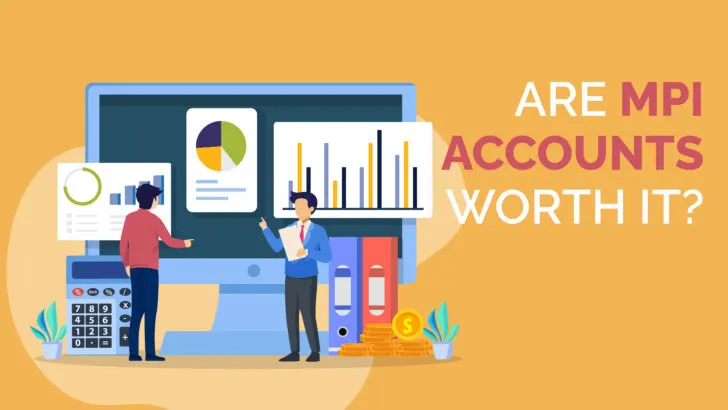MPI accounts, or maximum premium indexing, are the latest ‘viral trend’ promising to transform retirement savings.
Is it worth the hype?
No, and we’ll tell you why.
Table of Contents
What Is An MPI Account?

Maximum Premium Indexing (MPI) combines two important personal finance strategies: life insurance and retirement planning.
The life insurance portion is an indexed universal life insurance policy, which isn’t right for most people; however, some may benefit from the cash value life insurance policy (not many).
Indexed universal life insurance policies themselves are complex insurance products. They marry life insurance (death benefit guarantees) with an underlying index, such as the S&P 500.
Its ‘appeal’ is to provide regular income or money from the policy’s cash value to supplement your retirement income for the long term.
While several life insurance companies sell MPIs, Suncor Financial is the original founder of the program and is the company that went viral in its marketing for the product.
Are MPI Accounts Safe?
For all intents and purposes, MPI accounts aren’t safe for most people. There are much better retirement options to consider, such as your employer-sponsored 401K, which is safer and cheaper.
MPI accounts have so many downsides and ‘grey areas’ that it isn’t worth risking your future retirement funds to find out if they are legit. While you can lose money with any account, the largest red flag is the fact that Suncor talks about safety and growth for the same product.
However, anyone who has invested even a small amount of money knows you choose either safety (conservative investment asset classes) or growth (risky investment asset classes); you don’t get both.
How Does an MPI Account Work?
The claim for MPIs is they provide returns in three ways: protecting money with life insurance, growing money with stock market returns, and accelerating growth with leveraged investments (borrowing on margin).
This means that you invest in an indexed universal life insurance policy that eventually earns a cash value. What they don’t tell you is that this takes time, so much time that you might not see a positive return before the surrender fee period ends, which for MPIs is 14 years!
What Made MPI So Popular?
In short, TikTok made MPIs popular. This means its creators have great marketing skills and made the financial product seem so powerful that it went viral.
Curtis Ray, the creator of the program, is skilled at marketing and was able to get 1.5 million followers, making his videos about MPIs viral.
MPI vs. Traditional Life Insurance
MPIs come with a life insurance contract, but they aren’t advertised as a life insurance policy. Because there is a life insurance policy component, you must apply for the policy and get through underwriting, including passing a medical exam to be considered.
Traditional life insurance, however, only covers your death benefit. You purchase a policy, and your beneficiaries receive your death benefit when you die.
With an MPI account, you have the death benefit for your beneficiaries, but you also have money for yourself for living expenses during retirement.
Advertised Benefits of Having an MPI Account
MPI advertisements claim that it’s different from any life insurance or retirement account. They also claim you are better off with an MPI than an employer-sponsored 401K.
The advertised benefits include:
- 0% downside protection: This means you’ll never see a loss on your investments. However, what they don’t tell you is that the fees and loan interest (if you borrow on margin) could leave you in the negative.
- No early withdrawal penalties: This is an area of focus because most traditional retirement accounts have a 10% early withdrawal penalty, but this is only if you access funds before age 59 1/2, but MPIs don’t.
- Potential to accelerate your investment: MPIs advertise the RELOC or retirement equity line of credit you can use to borrow against your cash value to increase your returns.
Potential Drawbacks of MPI Accounts
- Extensive insurance costs: Life insurance policies are known for their high upfront costs plus the monthly premiums you don’t pay with retirement accounts. There are also ongoing fees that you’ll incur that most MPIs don’t disclose. The cost of insurance and hidden fees can quickly outweigh any gains in a declining market.
- Surrender charges: Even though MPIs don’t charge the 10% early withdrawal penalty, they have surrender charges that typically last through year 14, leaving you with little flexibility to access your funds.
- Tax risks: You’ll incur tax liabilities on your earnings within MPIs, and they won’t have the same tax benefits as tax-advantaged accounts like 401Ks or IRAs.
- Potentially lower returns: Not all the money you invest in your MPI goes toward your investment. A percentage must cover the life insurance premiums, which means lower returns on the same amount of money invested.
Considerations Before Opting for an MPI Account
Before choosing an MPI for your retirement account, consider the following:
Risks Associated With Investment in MPI Accounts
The largest risk associated with investments in MPI accounts is no guaranteed return rate.
Yet if you take advantage of the MPI Match Program, borrowing money against the cash value, you’ll pay 4% to 6% interest, which could leave you with a loss if the stock market isn’t performing well.
Eligibility Criteria
Unlike a 401K or IRA, you must be eligible for an MPI account. Since it’s an insurance product, you must apply for it and go through medical underwriting to see if you qualify. If approved, you then build your retirement plan with the insurance company.
Costs and Charges
The cost of MPIs is high.
Not only do you have your upfront ‘typical’ permanent life insurance company costs, but there are the interest charges on any money borrowed, the increasing premiums as the insurance renews every couple of years, plus there are surrender fees if you want to cancel the policy.
Tax Implications of MPI Accounts
If your cash withdrawals exceed the cost basis of the insurance policy, you’ll owe taxes at your ordinary tax rate on any earnings.
However, if you take the money from the the retirement equity line, technically, it’s not considered income since it’s funds from a loan. While Suncor Financial claims this is tax-free income, it still costs money since you pay 4% to 6% interest on the loan.
Finally, if you still have your policy when you die, any remaining cash balance goes to your beneficiaries tax-free.
Comparing MPI Accounts To Other Investment Vehicles
MPI accounts have a 0% floor, which, again, means you can’t lose, but that’s what they have you believe. Just because your returns won’t be negative doesn’t mean the insurance cost and other hidden costs don’t create a loss.
In addition, if you don’t have high enough returns to maintain your premiums, your policy could lapse, leaving you without any retirement income.
What Kind of IUL Is the MPI Plan Built On?
The IUL in an MPI account is the Max Funded Option B IUL. This type of IUL allows you to maximize your contributions while minimizing your insurance. MPI sellers would have you believe this is to your greater benefit when your money is likely better invested elsewhere.
What’s an IUL?
An IUL is an indexed universal life insurance policy that lasts for your lifetime. It’s a permanent life insurance policy that builds an account value over time (a long time).
It invests any non-premium funds in a stock index, such as the S&P 500. As your cash value grows, it can begin covering your premiums, leaving you with no cost.
IUL vs. 401K
401K accounts are retirement plans that allow before-tax contributions. This means you get the tax break today versus when you retire.
So, any money you withdraw from your 401K after age 59 1/2, you pay taxes on at your current tax rate. You don’t pay taxes on IUL funds unless the amount withdrawn exceeds your cash basis. Then, you would owe taxes on the difference.
IULs also don’t have early withdrawal penalties, but if you withdraw so much that you surrender the policy, you could pay a hefty surrender fee.
IUL vs. Roth IRA Account
Roth IRA accounts are after-tax accounts, much like the MPI. You contribute money after you’ve paid taxes on it, but your earnings grow tax-free. You have tax-free retirement income if you don’t withdraw funds until age 59 1/2 or later.
Like 401Ks, though, you pay a 10% penalty if you withdraw funds before age 59 1/2, but you don’t run into that issue with an IUL.
Is an MPI Account a Good Option for Retirement Planning?

An MPI account isn’t the best choice for retirement planning. Essentially, you use a loan to fund your retirement. Instead, you could invest the same money in your 401K or IRA up to the annual limits, get tax benefits, and have more control.
If you don’t want to include stock market investments in your retirement account, consider alternatives like real estate or starting a small business.
FAQs
Is the MPI a Scam?
The MPI account isn’t a scam, but it’s also not the best fit for most people. It’s risky, at the least, leaving people with much less money than they anticipated in retirement in exchange for lining the pockets of the insurance companies selling them.
When Is the MPI Account a Good Fit?
The only group in which MPIs may make sense are high-net-worth individuals who have maxed out their tax-advantaged retirement accounts and are looking for somewhere to invest funds.
If you can afford the high premiums and need a 0% floor investment, you might be a good fit, but only after exhausting all other investment options.
Can I Switch Between Different Investment Options Within an MPI Account?
No, unlike 401Ks or IRAs, you don’t have a say in which investments the MPI invests in because it invests in the underlying index, usually the S&P 500.
Is the Cash Value of an MPI Account Guaranteed To Grow?
There is never a guarantee an investment account can grow. While it has a 0% floor guarantee, which means no negative returns, no one can guarantee a positive cash value.
What Happens to the Cash Value if the Underlying Investments Do Not Perform Well?
The cash value of your MPI won’t grow if the investments don’t perform well. This could mean you won’t have enough to cover the premiums, and your policy could lapse.
What Is the Average Rate of Return or Performance History of MPI Plans Over the Years?
Historically, the S&P 500 has had a 10% average return, and Suncor’s MPI has had a 7% return.
Is an MPI Better Than a Roth IRA?
A Roth IRA is a tax-advantaged account for retirement. You contribute funds after tax, and your funds grow tax-free. An MPI account doesn’t offer the same tax benefits. It’s a life insurance policy with a potential cash value.
The Bottom Line
An MPI account is another fancy life insurance policy that promises big returns but usually doesn’t follow up.
It’s not worth risking traditional retirement accounts with employer-match and tax advantages for life insurance coverage that is nothing more than a loan to fund your retirement.
Samantha Hawrylack is a personal finance expert and full-time entrepreneur with a passion for writing and SEO. She holds a Bachelor’s in Finance and Master’s in Business Administration and previously worked for Vanguard, where she held Series 7 and 63 licenses. Her work has been featured in publications like Grow, MSN, CNBC, Ladders, Rocket Mortgage, Quicken Loans, Clever Girl Finance, Credit Donkey, Crediful, Investing Answers, Well Kept Wallet, AllCards, Mama and Money, and Concreit, among others. She writes in personal finance, real estate, credit, entrepreneurship, credit card, student loan, mortgage, personal loan, insurance, debt management, business, productivity, and career niches.

